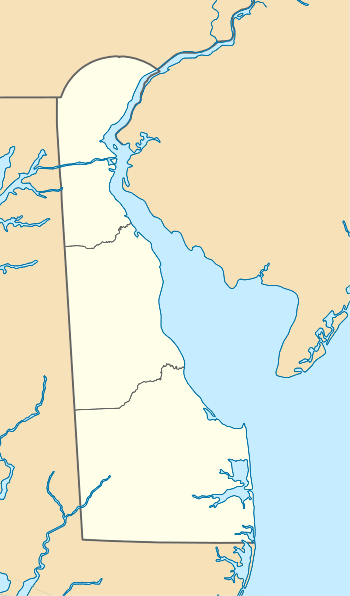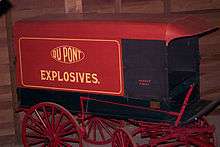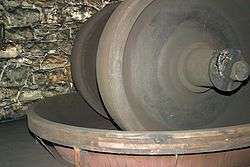Eleutherian Mills
|
Eleutherian Mills | |
|
Working powder mills on Brandywine Creek, about 1905. Note the handwritten "These blow up occasionally, and then?" | |
  | |
| Location | North of Wilmington on Delaware Route 141 at Brandywine Creek Bridge, near Wilmington, Delaware |
|---|---|
| Coordinates | 39°46′50″N 75°34′30″W / 39.78056°N 75.57500°WCoordinates: 39°46′50″N 75°34′30″W / 39.78056°N 75.57500°W |
| Area | 191.2 acres (77.4 ha) |
| Built | 1803 |
| NRHP Reference # | 66000259[1] |
| Significant dates | |
| Added to NRHP | November 13, 1966 |
| Designated NHL | November 13, 1966[2] |
From 1802 to 1921, Eleutherian Mills was a gunpowder mill site used for the manufacture of explosives by the Du Pont family business. The name also refers to the house on the hill above the mills, which was the first Du Pont family home in America. The business was founded by Eleuthère Irénée du Pont. In 1952, the site became an outdoor museum and the Hagley Museum and Library was founded.[3]
History
Jacob Broom built a cotton mill on the site in 1795. The mill burned down in 1797 and in 1802 he sold the site, complete with a working dam and millrace to Eleuthère Irénée du Pont, who paid $6,740 for the 95 acres (380,000 m2).[4]
The first domestic supplies of high-quality gunpowder were made in the US by E. I. du Pont de Nemours and Company.[5] The company was founded in 1802 by E.I. du Pont, two years after he and his family left France to escape the French Revolution.[6]

They set up the Eleutherian gunpowder mill on the Brandywine Creek just north of Wilmington, Delaware, based on gunpowder machinery bought from France and site plans for a gunpowder mill supplied by the French Government.[6] They also built housing for 30 workers.[4]
Starting, initially, by reworking damaged gunpowder and refining saltpetre for the US Government they quickly moved into gunpowder manufacture.[6]
Saltpetre was refined in an area between the house and the mills that now is occupied by a formal garden. Charcoal was produced from the willow trees that lined the Brandywine.
By the end of 1804, DuPont had sold 39,000 pounds of powder; the following year sales tripled. The Federal government and John Jacob Astor's American Fur Company became regular customers. In 1813 the Hagley property, just downstream from the original mills, was purchased, doubling the size and capacity of the mills. Sales grew during the Mexican-American War and the Crimean War. During the American Civil War, the firm sold 4,000,000 barrels of powder to the Federal government.
A major explosion killed 33 people in 1818. Another major explosion occurred on the site in 1847. In 1854 three gunpowder wagons exploded in the city of Wilmington.
The site
The mill buildings used in the manufacture of gunpowder were built with strong stone-walled structures on three sides; but were only covered by light wood structures on the fourth side, which faced out onto the Brandywine Creek. When an accident occurred, the explosion was directed away from the other mills and storage areas and over the creek.
Water power was provided from a mill race behind the mills, thus further isolating the mills in case of accident. One water wheel was often used to provide power to two mills. Water turbines were introduced in the 1840s. Alfred Victor du Pont acquired additional property, down stream from the Eleutherian Mills, to add to the manufacturing site. One of these properties was called Hagley, and it became known as the Hagley Yard.


Most of the industrial remains are located in the Hagley Yard. The mills were used in the purification, crushing, and mixing of charcoal, sulfur, and saltpeter. Other mills in the complex were used for glazing and corning, making metal powder kegs, and in cotton and woolen manufacturing. Stables, offices, a machine shop, and a steam powerhouse from the late 19th century also were located in the complex, as was a narrow gauge railway.
Rundown and closure
After the introduction of smokeless powder, the mills were to be closed in the 1910s, but were kept open at the request of the Federal government until after the end of World War I.
In 1952 family members donated 185 acres (0.75 km2) of land and the DuPont company established a $6,000,000 endowment for the Eleutherian Mill-Hagley Foundation for a museum of industrial history.
The site was declared a National Historic Landmark in 1966.[2][3]
It is located on Delaware Route 141 at the Tyler Mcconnell Bridge spanning the Brandywine Creek.
See also
Gunpowder
USA
Elsewhere
- Ballincollig Royal Gunpowder Mills
- Faversham explosives industry
- Waltham Abbey Royal Gunpowder Mills
References
- ↑ National Park Service (2010-07-09). "National Register Information System". National Register of Historic Places. National Park Service.
- 1 2 "Eleutherian Mills". National Historic Landmark summary listing. National Park Service. Retrieved 2007-09-27.
- 1 2 Richard Greenwood (1979) National Register of Historic Places Inventory-Nomination: Eleutherian Mills, National Park Service and Accompanying 12 photos, from 1966-1975
- 1 2 Kinnane, Adrian (2002). DuPont: From the Banks of the Brandywine to Miracles of Science. Wilmington: E.I. du Pont de Nemours and Company. ISBN 0-8018-7059-3
- ↑ Brown, G.I. (1998). The Big Bang: A history of explosives. Thrupp: Sutton Publishing Limited. ISBN 0-7509-2361-X.
- 1 2 3 du Pont, B.G. (1920). E.I. du Pont de Nemours and Company: A History 1802 to 1902. Boston: Houghton Mifflin. ISBN 1-4179-1685-0.
External links
- Historic American Buildings Survey (HABS) No. DE-2, "DuPont Powder Mill, Hagley Museum, on Brandywine River, Greenville vicinity, New Castle County, DE", 3 photos, 4 measured drawings, 3 data pages, supplemental material
- The DuPont Company on the Brandywine (digital exhibit produced by the Hagley Library that covers the early history of Eleutherian Mills)
- The Collection of DuPont Company powder yards on the Brandywine Creek photographs and the Gentieu collection of Brandywine River Valley images at Hagley Museum and Library contain approximately 400 images of this area between 1883 and 1936.


